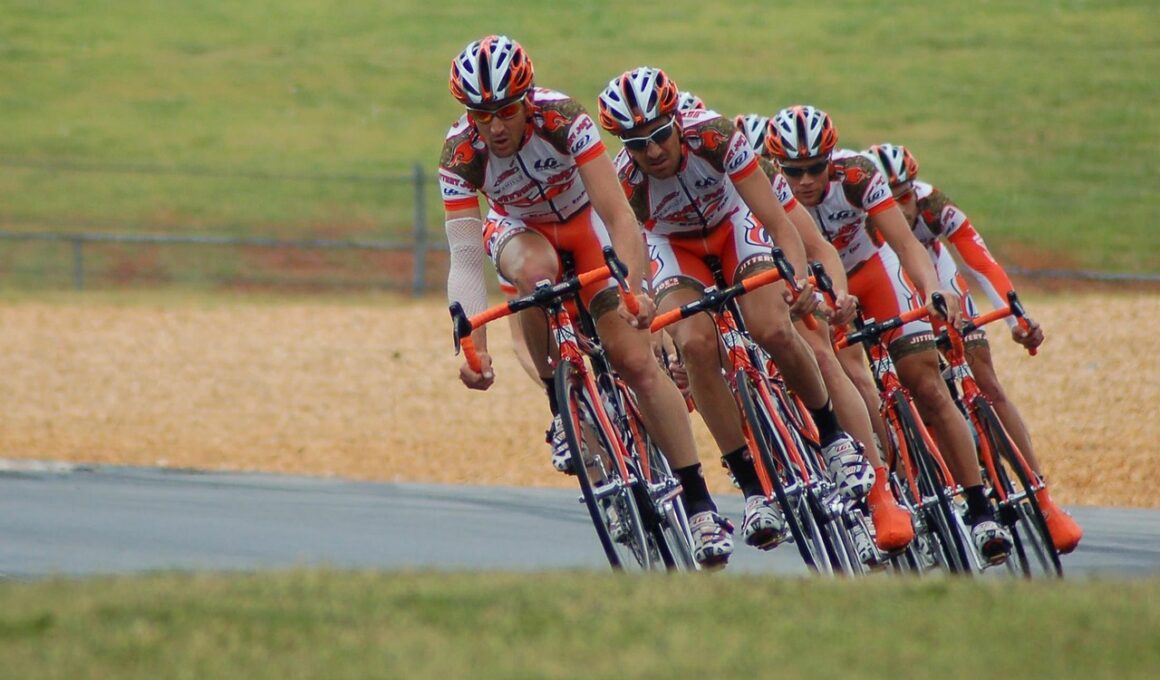HIIT for Cyclists: Tailoring Intervals to Your Fitness Level
High-Intensity Interval Training (HIIT) is a powerful workout regimen, especially popular among cyclists seeking to improve their performance. In essence, HIIT involves alternating periods of intense exercise with brief recovery phases. Cyclists can significantly benefit from this method as it enhances endurance, strength, and overall cardiovascular health. Incorporating HIIT into your cycling routine can lead to improved speed and stamina over time. Importantly, the structure of your HIIT sessions should cater to your current fitness level, ensuring optimized results while minimizing potential injuries. This approach allows for a tailored experience, making it more inclusive for beginners and advanced cyclists alike. When planning your HIIT workouts, consider your cycling goals and fitness baseline. Additionally, ensuring proper nutrition alongside your HIIT training can maximize benefits. Recovery is equally crucial, so always remember to listen to your body. Incorporate adequate rest and hydration to reap the rewards of your hard work on the bike. Experimenting with different intervals can keep your training fresh, making it easier to maintain consistency. Based on your fitness level, structure your intervals wisely to progressively challenge yourself.
Understanding Your Fitness Level
Before diving into HIIT, it is essential to understand your current fitness level, especially as a cyclist. Evaluating this helps you design effective intervals suitable to your abilities. Begin by assessing your current cycling endurance and speed. You might want to try a time trial or a steady ride to gauge your performance. Ranking yourself against different benchmarks can help you set a clear starting point. Once you have a baseline, consider what aspects you would most like to improve. Whether it is enhancing your sprint capabilities or increasing your time spent in a higher heart rate zone, knowing your specific goals shapes your HIIT approach. Many athletes benefit from consulting a coach or utilizing mobile apps specifically designed for cycling. These resources can provide insights and customized plans to further elevate your training. Monitoring your heart rate can also be invaluable during HIIT sessions, helping you adjust effort levels based on your physical reactions. Make sure to document your progress regularly, as it can motivate you on your cycling journey, ensuring you remain on track towards achieving personal bests.
One of the key elements of HIIT for cyclists is structuring your intervals, which can take various forms depending on your goals and fitness level. Common formats include short, intense sprints of 20-30 seconds followed by equal or longer recovery periods. Alternatively, you can attempt longer intervals lasting 1-4 minutes with a more extended recovery phase afterward. Experimenting with several formats can help determine what combination works best for you. As you progress, aim to increase the intensity of your intervals to keep challenging your body. Moreover, understanding how often to incorporate HIIT sessions into your routine is vital for optimizing results. A standard recommendation is to include 1-3 HIIT sessions per week, allowing ample time for recovery in between. Do not forget that proper warm-ups and cool-downs are crucial to prevent injuries and help with recovery. Additionally, consider complementing your intervals with resistance training to develop muscle strength that directly translates to better cycling performance. Such diversity in training can keep you engaged while providing an edge during races or long rides.
HIIT Session Example
To illustrate a practical HIIT cycling session, consider this example designed for intermediate cyclists. Start with a 10-minute warm-up at an easy pace. After warming up, begin with a series of intervals: 30 seconds of maximal effort, followed by 1 minute of recovery at a low intensity. Aim for a total of 5-8 repetitions of this cycle. Keep your heart rate elevated during the high-effort segments, pushing yourself while being mindful of your form. After the last interval, cool down with 10 minutes of easy cycling to facilitate recovery. Completing this workout will effectively engage your cardiovascular system while building both strength and speed. Specifically for cyclists, targeted muscle development during intervals translates directly to improvements in climbing and flat sections of rides. This unpredictability challenges your body’s adaptation over time. As your fitness improves, you can gradually increase the intensity and duration of the high-effort segments. Make sure to hydrate adequately before and after your session, and consider consuming protein afterward for muscle repair. With consistency, these sessions will enhance your cycling performance significantly.
Another exciting aspect of HIIT for cyclists is its adaptability to various environments. Whether you’re catching a ride outdoors or cycling on a stationary bike indoors, HIIT can be integrated into any setting. If commuting to work, you can sneak in short, high-intensity bursts during less busy stretches to maximize your ride. Alternatively, when inside, explore different resistance settings on your stationary bike to mimic terrain changes. Many indoor cycling classes embrace HIIT principles, incorporating bursts of speed throughout the offering. This versatility ensures that regardless of location, you can push your limits. Combine different cycling workouts throughout the week, diversifying your training to circumvent monotony and maintain motivation. Use apps or watch videos that guide you through structured HIIT sessions, aiming to replicate outdoor conditions indoors. The dynamic nature of HIIT not only enhances physical fitness but also engages your mental resilience. As you discover new ways to incorporate intensity, celebrate small victories to stay inspired on your journey. Cycling should be enjoyable; integrating HIIT elements can enrich your riding experience while achieving fitness goals.
Nutrition and Recovery
Nourishing your body is critical when incorporating HIIT into your cycling routine. Post-training nutrition plays a vital role in muscle recovery, aiding repair and growth to optimize your performance. After HIIT sessions, focus on consuming a balanced meal containing protein, carbohydrates, and healthy fats. For instance, a smoothie with whey protein, banana, and almond butter is quick to prepare and effective. Meal prep in advance can alleviate post-workout fatigue, ensuring nutritious meals are always on hand. Likewise, hydration before, during, and after exercising enhances performance and recovery significantly. Monitoring your hydration status can help adjust your intake based on the intensity and duration of your workouts. Additionally, implementing appropriate recovery techniques is equally crucial. Methods such as stretching, foam rolling, or taking ice baths can facilitate faster recovery. Consider incorporating rest days into your weekly routine to allow your muscles to rebuild and strengthen. Pay attention to your body’s signals, as fatigue and soreness are indicators you may need extended rest. Ultimately, when combined, nutrition and recovery ensure you remain prepared for the next HIIT workout, enhancing your overall performance and enjoyment.
Engaging in HIIT cycling introduces a range of benefits, from improved speed to enhanced endurance, and even mental toughness. Cyclists often find that varying their training keeps their routine exciting, enhancing their overall dedication. This fun aspect draws many cyclists to integrate HIIT into their weekly training sessions. Also, HIIT offers an effective workout in shorter durations, ideal for those with busy schedules. With only a few hours a week dedicated to cycling intervals, you can achieve remarkable results, making it easier to motivate yourself to maintain consistency. Sharing your journey with fellow cyclists fosters community and accountability, prompting even greater commitment to your goals. Regularly discuss achievements and feedback, as they play an essential role in your progress. Joining online cycling forums can help track your improvements through shared experiences and tips. Ultimately, envision your journey by setting realistic goals while focusing on your development. Every cyclist has an individual path, and embracing HIIT as part of that journey can lead to exciting outcomes. You may inspire others along the way, contributing to a greater cycling community dedicated to enhancing fitness and performance.
In conclusion, adhering to a structured HIIT regimen tailored to your fitness level can yield exceptional results for cyclists. By evaluating your capabilities, understanding how to integrate intervals effectively, and addressing nutrition and recovery, you set the foundation for substantial performance improvements. Commencing with shorter, intense intervals allows gradual adaptation, ensuring safety while maximizing effectiveness. Regularly assessing your progress helps in fine-tuning workouts to continue challenging both mind and body. Engaging with fellow cyclists provides motivation, thereby fostering consistency in your training. Be open to experimenting with different HIIT formats, as each offers unique benefits and experiences. Ultimately, while HIIT is rigorous, making it enjoyable enriches your cycling journey. Since cycling is both a physical and social activity, many find joy in the shared passion amongst peers. Striving towards personal goals while supporting others creates a stronger community. Persisting through high-intensity training certainly shapes not just your cycling performance but also your mindset. Thus, embrace the workouts and strive to push your limits responsibly. In doing so, you will unlock your true cycling potential, transforming your approach to fitness and completing rides with newfound strength.


